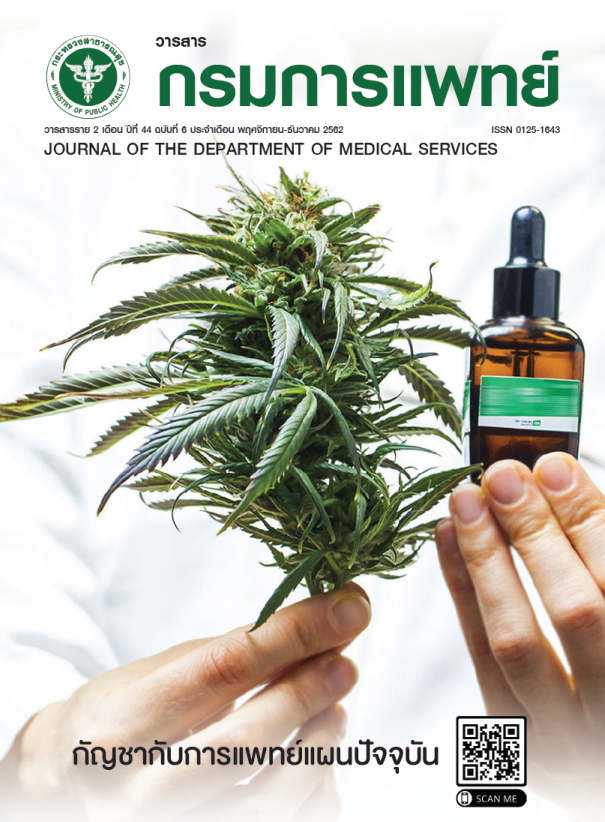IMRT/VMAT in Nasopharyngeal Carcinoma Patients : An Analysis of 33 Cases
Keywords:
Nasophayngeal carninoma, IMRT, VMATAbstract
Nasopharyngeal carcinoma is common cancer in Southeast Asia and Thailand. IMRT (Intensity-modulated radiation therapy) and VMAT (Volumetric modulated arc therapy) are advanced techniques radiotherapy in the treatment of nasopharyngeal carcinoma. This study aimed to evaluate efficacy in the treatment of nasopharyngeal carcinoma with IMRT/VMAT at Ubonratchatani cancer hospital from July 2014 to December 2016. The data were reviewed including demographic data, pathological finding, stage of the tumor, radiation techniques, radiation doses to target volumes, radiation doses to normal organs, responses of treatment, survival rate and toxicities. Thirty-three patients were recruited. The result was found that 81.8% of patients had VMAT treatment and most of the patients use SIB technique 93.9%. After treatment, 69.7% and 30.3% of the patients had a complete and partial response, respectively. Median follow up period was 42 months. The 3-year progression-free survival was 72.7% and 3-year overall survival was 81.8%. Most toxicities were not severe. Acute side effect grade 1 and 2 mucositis were found 36.4% and 63.6% respectively. The common side effect was grade 1 xerostomia (57.6%) and grade 2 xerostomia (24.2%). From this study, we can achieve good results with high survival rate and acceptable toxicities when treating nasopharyngeal carcinoma patients with IMRT/VMAT.
References
Curado MP, Edwards B, Shin HR, Storm H, Ferlay J, Heanue M, editors. Cancer in fivecontinents, Vol. IX. IARC Scientific Publication No. 160. Lyon: IARC; 2007.
Imsamran W, Chaiwerawattana A, Wiangnon S, Pongnikorn D, Suwanrungrung K,Sangrajrang S, et al editors. Cancer in Thailand Vol. VIII, 2010-2012. Bangkok, Thailand:Bangkok Medical Publisher; 2015.
Cheng JC, Chao KS, Low D. Comparison of intensity modulated radiation therapy (IMRT) treatment techniques for nasopharyngeal carcinoma. Int J Cancer 2001;96:126–31.
Kam MK, Chau RM, Suen J, Choi PH, Teo PM. Intensity-modulated radiotherapy in nasopharyngeal carcinoma: Dosimetric advantage over conventional plans and feasibility of dose escalation. Int J Radiat Onc Biol Phys 2003; 56: 145–57.
Xia P, Fu KK, Wong GW, Akazawa C, Verhey LJ. Comparison of treatment plans involving intensity-modulated radiotherapy for nasopharyngeal carcinoma. Int J Radiat Oncol Biol Phys 2000;48:329–37.
Otto K. Volumetric modulated arc therapy: IMRT in a single gantry arc. Med Phys 2008;35:310-7.
Verbakel WF, Cuijpers JP, Hoffmans D, Bieker M, Slotman BJ, Senan S. Volumetric intensity-modulated arc therapy vs. conventional IMRT in head-and-neck cancer: a Comparative Planning and Dosimetric Study. Int J Radiat Oncol Biol Phys 2009;74:252–9.
Edge S, Byrd DR, Compton CC, Fritz AG, Greene F, Trotti A, editors . AJCC Cancer Staging Manual. 7th ed. New York: Springer; 2009.
Chan J, Bray F, McCarron P, Foo W, Lee AWM, Yip T. Nasopharyngeal carcinoma. In: Barnes EL, Eveson JW, Reichart P, Sidransky D, editors. Pathology and genetics of head and neck tumor. World Health Organization classification of tumours. Lyon: IARC Press; 2005.p.85-97.
Lee N, Harris J, Garden AS, Straube W, Glisson B, Xia P, et al. Intensity-modulated radiation therapy with or without chemotherapy for nasopharyngeal carcinoma: radiation therapy oncology group phase II trial 0225. J Clin Oncol 2009;27:3684–90.
Lee N, Zhang Q, Kim J, Kim J, Garden AS, Mechalakos J, et al. Addition of bevacizumab to standard chemoradiation for locoregionally advanced nasopharyngeal carcinoma (RTOG 0615): a phase 2 multi-institutional trial. Lancet Oncol 2012;13:172–80.
Songthong A, Chakkabat C, Kannarunimit D, Lertbutsayanukul C. Efficacy of intensity-modulated radiotherapy with concurrent car boplatin in nasopharyngeal carcinoma. Radiol Oncol 2015;49:155–62.
Milano, MT, Constine, LS, Okunieff P. Normal Tissue Tolerance Dose Metrics for Radiation Therapy of Major Organs. Seminars in Radiation Oncology 2007;17:131–40.
แนวทางการรักษาผู้ป่วยโรคมะเร็งโพรงหลังจมูก (Nasopharyngeal cancer) ใน : คู่มือ แนวทางการรักษาโรคมะเร็งในผู้ใหญ่ พ.ศ. 2561 เพื่อขอรับค่าบริการสาธารณสุข ในระบบหลักประกันสุขภาพแห่งชาติ.กรุงเทพฯ : สหมิตรพริ้นติ้งแอนด์พับลิสชิ่ง ; 2561 หน้า 53-60.
National Cancer Institute. Common Terminology Criteria for Adverse Event (CTCAE) Version 4.0 [Internet].Bethesda(MD) :2010 [cited 2010 June 14]. Available from:https://ctep.cancer.gov/protocol development/electronic_applications /docs/CTCAE_v4_Quick_Reference_8.5x11.pdf.
Songthong AP, Kannarunimit D, Chakkabat C, Lertbutsayanukul C. A randomized phase II/III study of adverse events between sequential (SEQ) versus simultaneous integrated boost (SIB) intensity modulated radiation therapy (IMRT) in nasopharyngeal
carcinoma; preliminary result on acute adverse events. Radiat Oncol 2015;10:166.
Han L, Lin SJ, Pan JJ, Chen CB, Zhang Y, Zhang XC, et al. Prognostic factors of 305 nasopharyngeal carcinoma patients treated with intensity-modulated radiotherapy. Chin J Cancer 2010;29:145-50.
Wong FC, Ng AW, Lee VH, Lui CM, Yuen KK, Sze WK, et al. Whole-field simultaneous integrated boost intensity-modulated radiotherapy for patients with nasopharyngeal carcinoma. International journal of radiation oncology, biology, physics 2010;76:1 38–45.
Emma B. Holliday, Steven J. Frank. Proton therapy for nasopharyngeal carcinoma.Chin Clin Oncol 2016;5:25.
Wolden SL, Chen WC, Pfister DG, Kraus DH, Berry SL, Zelefsky MJ. Intensity-modulated radiation therapy (IMRT) for nasopharynx cancer: update of the Memorial Sloan-Kettering experience. Int J Radiat Oncol Biol Phys 2006;64:57–62.
Downloads
Published
How to Cite
Issue
Section
License
บทความที่ได้รับการตีพิมพ์เป็นลิขสิทธิ์ของกรมการแพทย์ กระทรวงสาธารณสุข
ข้อความและข้อคิดเห็นต่างๆ เป็นของผู้เขียนบทความ ไม่ใช่ความเห็นของกองบรรณาธิการหรือของวารสารกรมการแพทย์



